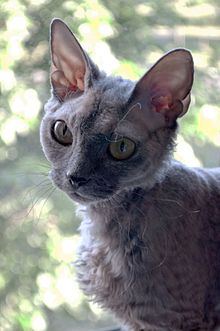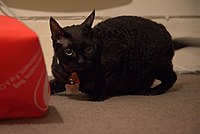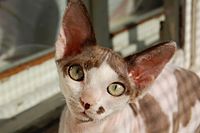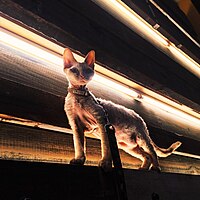| Devon Rex | |
|---|---|
 | |
| Origin | |
| Breed standards | |
| CFA | standard |
| FIFe | standard |
| TICA | standard |
| ACF | standard |
| ACFA/CAA | standard |
| CCA-AFC | standard |
| GCCF | standard |
| Domestic cat (Felis catus) | |
The Devon Rex is a tall-eared, short-haired breed of cat that emerged in England during the late 1950s. The breed is known for its atypical appearance, with an oddly shaped head, large eyes, and the short and wavy coat.
History
[edit]Origin
[edit]Beryl Cox came across a novel curly-coated kitten in Buckfastleigh, Devon in 1960 whom she decided to name Kirlee. Originally, Cox believed the cat's gene to be related to the Cornish Rex which led to her breeding Kirlee with Cornish Rexes. However, when the queen gave birth the kittens all had straight coats, which led to the discovery that Kirlee had a different mutation than Cornish Rexes. Following this Cox began a breeding program to try and preserve Kirlee's unique mutation.[1]
Appearance
[edit]The Devon Rex is a very short haired breed with a medium build and a unique head type which gives the breed a 'pixie-like' appearance. The head is short with a broad wedge and the brow curving to a flat skull. The eyes are large, set wide, and oval-shaped. Devon Rexes may have any eye colour. The ears are large and set wide apart with rounded tips. The coat is short dense and soft and curls inwards a little giving it a waved or rippled effect. Some areas of the body such as the neck may lack enough fur for the wave/ripple effect. The whiskers and eyebrows are crinkled and twisted. Devon Rexes may come in any colour.[2]
Health
[edit]Hereditary myopathy is found in some Devon Rexes. It is caused by a genetic variant known as COLQ and it appears anytime from 3 to 23 weeks of age.[3] Typically, there is a chance that the myopathy in the cats might stabilize, however, most of the time, the condition worsens and the Devon rex cats die from laryngospasm, after obstructing their larynx with food. [3][4][5]
The Devon Rex was found to be predisposed to feline atopic dermatitis in a retrospective study of cases of the disease.[6]
The Devon Rex is predisposed to congenital hypotrichosis and Malassezia dermatitis.[7]
Gallery
[edit]-
A black Devon Rex.
-
A "blue smoke" Devon Rex with unusually large ears.
-
Devon Rex cats with Siamese (colourpoint) colourings are known as Si Rex.[citation needed]
-
A cream Devon Rex with curly, soft coat typical to this breed
-
A Devon Rex with white spotting on a chocolate coat
-
An orange Devon Rex
-
A tortoiseshell Devon Rex
-
A devon rex kitten in Australia walking on a leash
See also
[edit]References
[edit]- ^ Puisis, Erica. "Devon Rex". The Spruce Pets. The Spruce Pets. Retrieved 26 January 2024.
- ^ "Devon Rex Standard" (PDF). Governing Council of the Cat Fancy. Retrieved 26 January 2024.
- ^ a b Malik, R.; Mepstead, K.; Yang, F.; Harper, C. (November 1993). "Hereditary myopathy of Devon rex cats". Journal of Small Animal Practice. 34 (11): 539–545. doi:10.1111/j.1748-5827.1993.tb03544.x. Retrieved 26 October 2022.
- ^ Martin, Paul; Shelton, Diane; Dickinson, Peter (December 2008). "Muscular dystrophy associated with alpha-dystroglycan deficiency in Sphynx and Devon Rex cats". Neuromuscular Disorders. 18 (12): 942–952. doi:10.1016/j.nmd.2008.08.002. PMC 2646259. PMID 18990577. Retrieved 26 October 2022.
- ^ Gandolfi, Barbara; Grahn, Robert; Creighton, Erica (16 September 2015). "COLQ variant associated with Devon Rex and Sphynx feline hereditary myopathy". Animal Genetics. 46 (6): 711–715. doi:10.1111/age.12350. PMC 4637250. PMID 26374066.
- ^ Ravens, Philippa A.; Xu, Bei J.; Vogelnest, Linda J. (2014). "Feline atopic dermatitis: a retrospective study of 45 cases (2001–2012)". Veterinary Dermatology. 25 (2): 95. doi:10.1111/vde.12109. ISSN 0959-4493.
- ^ Hnilica, Keith A.; Patterson, Adam P. (19 September 2016). Small Animal Dermatology. St. Louis (Miss.): Saunders. ISBN 978-0-323-37651-8.


![Devon Rex cats with Siamese (colourpoint) colourings are known as Si Rex.[citation needed]](http://upload.wikimedia.org/wikipedia/commons/thumb/1/19/Si_rex.jpg/200px-Si_rex.jpg)




